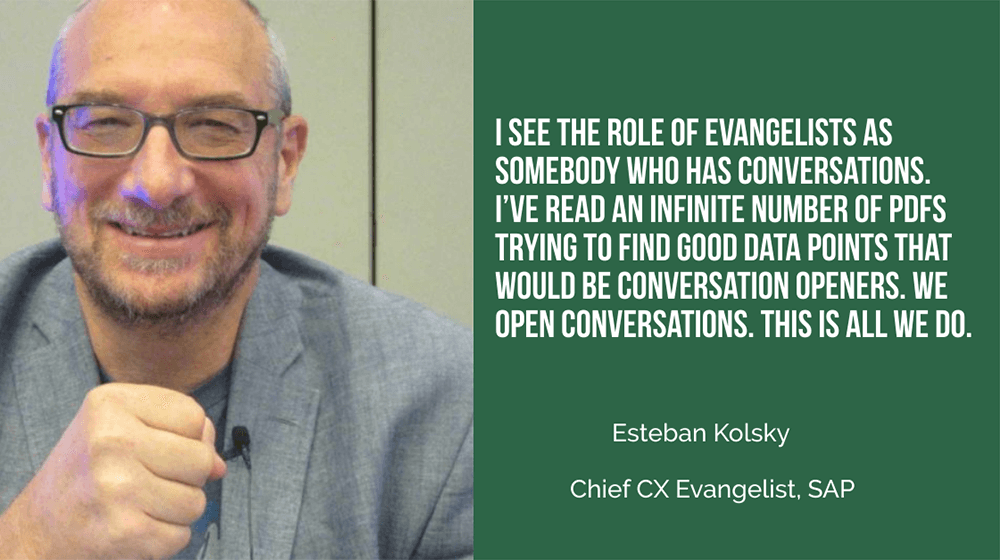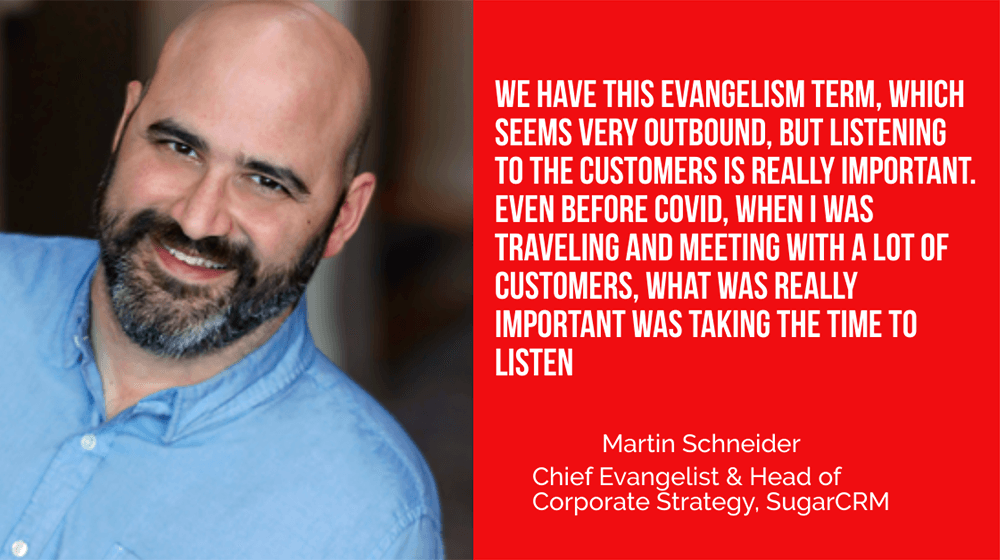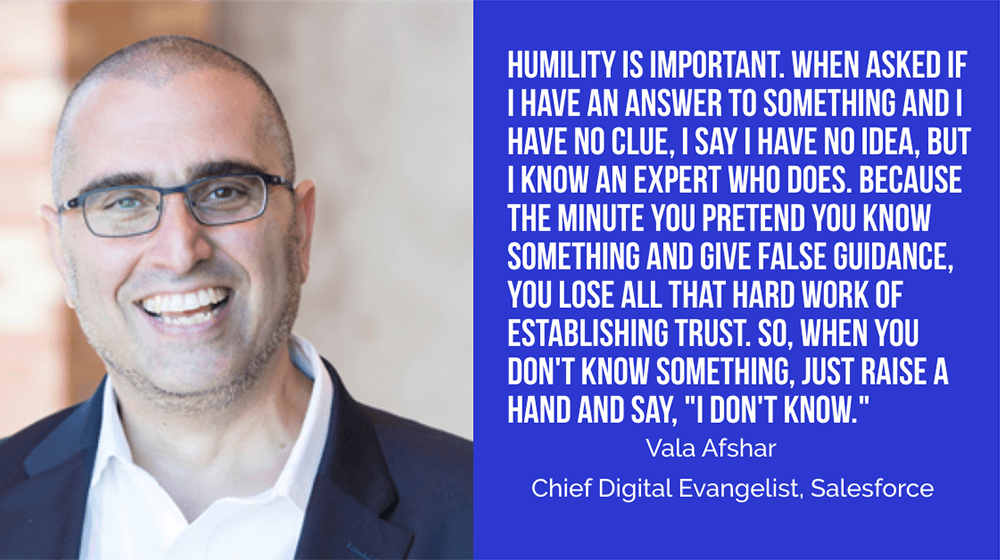
The term “evangelist” has been thrown around a lot over the past couple of years. I’m not talking Jimmy Swaggart, TD Jakes or Joel Osteen. I’m talking about the evangelist role in terms of technology and business. But what does that mean and what do they really do?
Recently me and my CRM Playaz co-host Paul Greenberg hosted a LinkedIn Live conversation with three of the leading CRM vendor evangelists to dig in a bit and find out what it really means to be an evangelist, what they do and how it differs from the perceptions out there for who evangelists are. Joining us were:
- Vala Afshar, Chief Digital Evangelist for Salesforce
- Esteban Kolsky, Chief CX Evangelist for SAP
- Martin Schneider, Chief Evangelist and Head of Market Strategy for SugarCRM
Below is an edited transcript from a portion of our conversation. To hear the full conversation click on the embedded SoundCloud player.
Defining Evangelism in CRM
Paul Greenberg: Vala, how does Salesforce look at it? How do you look at it given your role at Salesforce? Because you have a very big public presence, too.
Vala Afshar: When I think of the word evangelist in the technology space, the first name that comes to mind for me is Guy Kawasaki. I think he was the first individual, when he was working for Jobs bringing Apple 2 to market, publicly labeled as an evangelist. I take no credit for the title. The title was given to me by Alex Dayon five years ago. Alex was President of Products at Salesforce, and it was Alex who suggested the title. I tend to lean definitely towards Esteban’s view in terms of … I’ve had people that have followed me for years, didn’t know I worked at Salesforce, so I rarely, if ever, speak to products. But as a 12 year customer of Salesforce, my company became a customer in 2003 and in ’04 we launched Service Cloud Sales Cloud, so really early on, I’ve been with the company five years, so 17 years I’ve been with the company, but 12 as a customer. My point of view in terms of storytelling is based on a practitioner’s point of view.
I ran engineering when I was tasked to bring Salesforce into our company and then services support and then my last assignment was CMO. A lot of the writing and the content for podcasts or anything that I produce, really speaks to market trends, line of business, roles and responsibility of a CIO, CDO, CMOs, because I served in that capacity. I have 54,000 colleagues that speak to products and our solution set. We’re not configuring a product and can’t use the product. It’s just, I think, to educate and inspire and cut through the noise that exists today, you really have to speak to outcomes. You need to speak to the why, not the what and the how. The product is the what and the how. The why, I think, is what you need to overcome, where your story resonates.
Paul Greenberg: So Esteban, what’s the day to day in your case too? I mean, I know it’s newly minted, it’s a newly minted role at SAP, period.
Esteban Kolsky: One third of my job is educating the people of what it is to be an evangelist and how to engage me. I’m sure that Vala had some of that at the beginning when he was brought in by sales people or account executives, and were like, “Okay, we’re trying to close this deal, would really, really help if you can say commerce is the best thing ever.” But that’s not how it’s going to happen because I could say whatever, but if I don’t have the data or I don’t have the stories to tell behind it, it really doesn’t go anywhere. So once I get past that education, it’s mostly research and finding information, talking to customers, talking to you guys, talking to consultants, talking to everybody. Like I said, it’s the same job that I did as an analyst. You just aggregate information and then put together stories.
Virtual Evangelism
Vala Afshar: My entire company received an email from our head of legal first week of March that said no more travel. I was on the road probably 40, 50% of the time, engaging with customers, partners, conferences, events, so that faucet was turned off. So I immediately made the determination that 2020 was going to be the year of content. And so from March to present day, that translated to 122 ZDNet articles, another 20, 30 articles in other publications, so I’m writing three, four articles a week. Ray and I, Ray Wang and I, did 50 plus podcasts, religiously, weekly, and then probably even more number in terms of keynotes and what we call SICs which is Intimate Workshops with Customers. So that’s the source of the articles, the show, and then the almost daily … I just left a customer call before this session. It gives me plenty of opportunity to identify good stories and good people and good outcomes.
Keys to Effective Evangelism – Listening and Reading

Esteban Kolsky: I read an infinite number of PDFs in the last three weeks trying to find good data points that would be like conversation openers. I see the role of evangelists as somebody who has conversations. We open conversations. I mean, this is all we do. You need to have a good conversation opener. 86% people will change their providers because of a bad experience. That’s a bad opener because it’s crap. But you know, 70% of companies actually evolved their digital revolution last year by at least three months and at most three years, that’s a good opener.
So it’s just finding and updating information that you’re going to take to open the conversations, and then it’s what Vala said. I mean, after that, where are you and what do you need? Do we need to align the executive team with a workshop behind a common purpose? Do we need to do a little discussion, like a round table around this? Can we bring 10, 15 customers and have a discussion about what it was like to survive COVID as a company in the airline industry? I mean, it really varies.
Martin Schneider: For me, it’s a lot of what Esteban is talking about. What I think is really important for me is we have this evangelism term, which kind of seems very outbound, but the listening to the customers is really important. Even before COVID, when I was traveling and going out there and meeting with a lot of customers, what was really important was taking the time to listen. We had a really fascinating couple of engagements where we went in with some kind of like, okay, these guys are having some trouble, they’re doing this kind of stuff, and just listening and being that person in the room who wasn’t a salesperson, who wasn’t the product guy, and who wasn’t maybe the deployment partner from the IT or from the SI side, and just listening to, “What are you trying to do??
Not, “What are you trying to do with Sugar,” for example, or, “What’s this process or that.” And trying to bring it up a bit and saying, “What are your problems? What are your goals?” And then being able to kind of retrack, sometimes come back out, realizing that possibly the partner wasn’t the right partner for different reasons, or possibly the product that they were using and the combination of products that they were using, weren’t the right ones. Putting Sugar in, taking Sugar out sometimes in some facets. And really just listening. And that was really fascinating. Being able to do that even easier now, because I can do it at much more scale. That’s a big one.
Bringing the Outside World View Back Inside
The interesting part about what I do is still running so much of product marketing and doing all that kind of stuff, I get to have all these interactions and then bring back a lot of feedback. So again, listening, and then putting that back into our release cadence in what we’re doing, has been a lot of fun because I can come out there where you’ve got engineers who are just basically sitting at computers, typing code, giving them the reason why this should be prioritized over that one. So really cool stuff there.
But then it’s been really busy over the last couple of years with the company because we’ve rebranded, we’ve made this wholesale move to a cloud-first portfolio, we’re rolling out these AI products that are really real stuff. Firmly embedded in the product, not something you have to go out and buy and hope it works and do a big deployment. It just works on day one. So there’s been a lot of the kind of behind the scenes work with that. It’s almost a blessing and a curse. I would have been annoyed if I was doing all this internal work over the last year, not being able to spend this time out there at events, doing all this stuff. This work needed to get done, so it’s was almost lucky that COVID happened so I could take the time with the team to go in there and really re-spin some messaging, re-spin some of the high level kind of positioning and versions. But also just really get some amazing products out there.
We’re now embedding seamless omni-channel, AI, cool stuff. Not to be [inaudible 00:09:37] stuff, but things are really exciting to me and things that I can spin stories around that I would have been bogged down in that and not being able to be at an event or something like that. Now I can’t be at the event, but I can log in and go do something virtual that takes me 90 minutes instead of three days. So it’s been really a kind of weird productivity boost for me to be able to play both those internal and external roles almost better than ever before over the last year.
Esteban Kolsky: Truly honestly, the bigger value to our employers is bringing back everything that we find and then disseminate it internally. I know I talked about this with Vala before, how sometimes it’s really hard to find the right people to give the right information and everything. You have to have internal vision of how you’re actually going to coordinate and create a coherent message across a company. Your role is to bring back what’s important, but also make sure that everybody within the company speaks the same language and tells the same stories.
I mean, we all work for complex companies with lots of products and it would not be unheard of to have three different things said by three different people about the same solution, the same products. The internal effort is more coordination and coherence than it is like evangelism.
You know, the people that work in product, the people that work in sales, the people that work in product marketing, they have a goal and an objective that is different than mine. My objective is to create a good conversation, to create a good framework in which to make a decision by the customer. That’s my only objective. So I can actually do what Martin and Vala said and listen with an open mind instead of going, “Oh, this one, I’m going to say my feature solves that product,” instead of going like, “Okay, I’m trying to understand everything that you’re saying,” and trying to understand at the level that I’m talking to, whether it’s an executive level or a lower level, different level of conversations, and then provide value to that by adding data points, by adding stories to that, and then have them walk away with a better framework in which to make the decision.
Words for aspiring evangelists

Vala Afshar: Aspiring evangelists listening, measure your success by repeat conversations. Are you invited again to the table with the client? That’s one measure. How many times do you have one conversation and never see the client again? If that’s the case, you need to adjust your methodology because success is … Godfather of CRM once said, “Customer engagement is the ongoing interaction between the company and the customer, offered by the company, chosen by the customer.” Just replace company with evangelist. If they choose to come back to you, ongoing, you’ve got a healthy engagement. But if it’s a one-off you don’t. So that’s one.
The other is how much of a connector you become over time. Are you connecting the person that you’re advising to other members of your organization? The more successful you are as a trusted advisor, the more connections you’re going to make, because you don’t have all the answers. So, humility is important. When somebody asks me as the chief evangelist, if I have an answer to something and I have no clue how to advise them, I say, “I have absolutely no idea how to provide your feedback, but I do know an expert in this area. Let’s make a connection.” And it’s really rewarding when you take advantage of the network effect and create an ecosystem of trusted advisors, because that’s when you sustain momentum. And the minute you pretend you know something and you give false guidance, you lost all that hard work of establishing trust. So, when you don’t know something, just raise a hand and say, “I don’t know.”
This article, “Esteban Kolsky of SAP: The Role of an Evangelist is to Open Conversations – This is All We Do” was first published on Small Business Trends